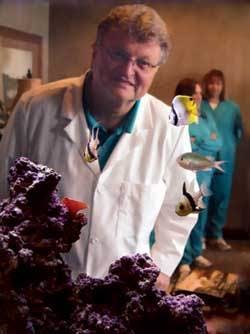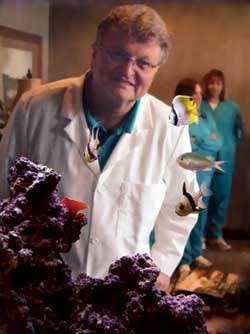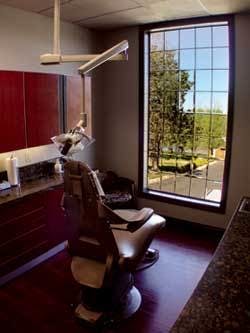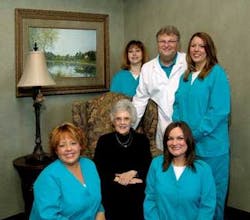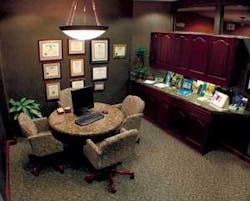ON the shoulder of giants
This month Dental Economics® speaks with Dr. Charles A. Vogel of Heard, Heard and Vogel in Springfield, Mo. In a far-ranging interview, Dr. Vogel talks about how he became involved with implant dentistry, discusses the unique approach taken in his office design, and reflects on those individuals who have played key roles in his dental career, which spans some 40 years.
DE: What specialty niches are you currently concentrating on with your practice?
Dr. Vogel: About five years ago, I began to think of ways to transition my practice in a way that allowed me to continue to do some of the things that I like the most while passing on the rest of the general practice to a young mentor-associate who could possibly take over the entire practice in a few years. In evaluating the situation, I realized how much I really enjoy dental implants - not only the prosthetic portion but the surgical component as well. I began working with dental implants in 1987, and had done only a few surgeries. As I began to get more training with the surgeries, and as I began to expand and explore that aspect, I realized how difficult it was to do implant surgery without having the end in mind and without being able to visualize the final prosthesis. I began to feel sorry for oral surgeons who had been placed in the awkward situation of trying to satisfy an end of which they ouldn’t completely and fully recognize where they were going. The more I pursued this, the more I enjoyed it. So, I began to grow and develop thce surgical niche of my general practice. At the time, I did not realize how effective some of the up-and-coming advertising media, such as the Internet, would be in allowing me to do this. Also, I began to realize that the cosmetic end of my practice was lacking in some ways. In fact, besides doing veneers and crowns, the only way that I was helping adults was to do some minor tooth movement with removable appliances. I searched and located a young dentist from Ohio by the name of Dr. Richard DePaul. Through several courses, Richard taught me a technique he refers to as the PowerproxSix Month Braces® Technique. This procedure allows me to plan treatment much more adequately for the 30- to 50-year-old male or female who has not enjoyed perfectly straight teeth but may have enjoyed a fairly caries-free mouth and has relatively healthy teeth and would like a better appearance. Now, I have developed the adult part of my orthodontic practice to such an extent that - as of last quarter - adult orthodontics and implant dentistry represented 44 percent of my production. It is my goal that by the time my new associate comes on board in July, I will have increased production to 50 percent. This will allow me to transition in such a way that my general practice can be taken over by a mentor-associate as that person’s speed and skill grow. I then can remain in the practice but spend less time by doing the highly productive implants and adult orthodontics.
DE: What are your thoughts about dental implants?
Dr. Vogel: Certainly, dental implants already have and are going to continue to change the total concept of the way we practice dentistry. This primarily has to do with predictability and the fact that implants can be altered from being a crown abutment to an overdenture abutment - or other kinds of attachments - just by screwing and unscrewing things. I am not recommending that we remove healthy teeth and replace them with implants just because they are easy to work with. I do think that, in the next 10 years, we are going to see teeth sacrificed much earlier. So, if good, uninfected bone is available, then a dental implant can be placed - if not immediately then soon - into a healthy site. This will give you a bridge abutment or something that is going to be solid and not subject to fracture and reinfection. Right now, I refer to dental implants as growing a titanium root in a patient’s jawbone, then putting a tooth on top of it. In reading recent literature, I understand that - probably within 15 years - the dental implantologist will actually implant a tooth bud in that area and let a tooth regrow in that space. At this juncture, from a technical and medical standpoint, this seems feasible. Again, I think in the case of the dental implant, we are seeing only a tiny tip of the iceberg and what that may involve. The word “dental implant” might better be called “tooth replacement implant” to cover all the different ways we can grow and replace teeth.
DE: What approach did you use in your office design? When did the redesign take place?
Dr. Vogel: In designing the office, we took what I thought was a unique approach. First, we formed a small group of three doctors in 1994. With the help of R.L. Frazer & Associates, we agreed on some philosophy, vision, and mission statements about where we wanted the practice to go and how we wanted to get there. Dr. Frazer’s strategic planning approach helped us to look 10 years into the future as to what the world of dentistry might look like. At the time, we were able to envision what the future might be without the technology of the time but with entirely new or different technology that was emerging. Then, late in 1998, my partners - brothers Jeffrey Heard and John Heard - traveled with me to Austin, Texas, to visit with THE Design, Inc. I often introduce myself at dental meetings as a futurist and a philosopher who happens to practice dentistry because I love it. In that role, I certainly agitated and irritated my partners, as well as some of the design people who I pushed out of their comfort zones to think about an office that was front deskless, had a point-of-service checkout, and had a private business office from which we could call about accounts and insurance without clients in the reception room overhearing. We have areas in our office where financial arrangements can be made personally and privately. In fact, we actually have several of these areas. We have two consult rooms where we meet and greet new patients and make most of our major presentations. We have mini-checkout areas that aid the treatment coordinator in the discussion of finances. Some dentists call this space that doesn’t involve treatment a waste. In some practices, this space might be a waste. But in our office, the way we practice high-dollar investment procedures and the extensiveness of what we do, it is a better idea to guarantee confidentiality and a personal touch. Thus, decisions about design must be made on a practice-to-practice basis based on what functions best. While our design is the best for us, it may not be for someone else. Because of certain events that happened along the way, the timeline for completion of the office stretched further than we intended. The office was finished in April 2000. This actually turned out to be a blessing. It allowed us to add the digital radiography as a basic part of the office design rather than having to add it later. When you have to add major technology, sometimes it appears like you tacked on an extra room to your house. The technology doesn’t look like it fits as well as if it had been part of the initial design. So, if you are considering the design of an office, it is important to look into the future and see what things could be coming and make provisions for them. For example, we wired the current office with CATV5 in some 45 places for computer use. Little did we know that, by now, we could have a wireless network and that wouldn’t be such a huge deal. But we are hardwired for these 45 computer stations, although we only use about 30 today. A little extra cost, up front, to plan for the future is a good thing to consider. As we tried to decide about some of the features from our old office, we tested different products. One of the doctors tested several different lights and other sterilization systems. Ultimately, we were able to choose systems that best fit our needs.
DE: What do you consider to be some of the notable patient-staff features in your practice?
Dr. Vogel: From the time one enters our facility, I think we have created an environment of respect for each other and our patients. We have handicapped-accessible parking within 30 feet of our front door, a covered porch that is especially handy during inclement weather, valet parking, and parking for senior-aged patients nearby. Sliding doors automatically open as people enter the facility. With the hot and cold weather extremes in our geographic area, the sliding doors create an air lock to keep temperatures balanced. Patients are greeted by a concierge-hostess.This person makes everyone feel at home, and offers hot or cold beverages to patients while making sure they are comfortably seated. Patients are not able to hear the usual dental handpiece noise or dental chatter because of acoustical barriers and glass walls that create what Dr. Omer Reed refers to as the “cone of silence.”
Patient comfort transcends the office. We have a Comfort Spa towel warmer, and each person receives a heated, moist disposable towel to freshen his or her face before departing. Patients also are offered bottled water as they leave rather than going to the traditional office water fountain.
Without patients and our team, we wouldn’t have a need for all the beautiful and comfortable amenities. This is why forming lasting relationships and treating people with utmost respect is at the foundation of all we do.
The effort to create a good working environment for our team is important because the team is the group of people who make everything happen. The lunch room has a complete kitchen, dishwasher, inhouse laundry, personal changing rooms, and vanity areas. This may sound a little unrealistic. But, as a small group practice that only needs one washing machine and one kitchen to serve 20 to 30 people, the costs - when shared by each doctor - are extremely low. But the benefits to employees and the practice as a whole are immense. Again, having a small group practice can make dreams become more real.
The delivery door, though left totally unattended, has a security keypad. Delivery people who come and go throughout the day are given access codes so they won’t interrupt us.
We have a room that can be locked and is dedicated to storing supplies. This allows us to take advantage of quantity discount buying with all of the major suppliers. Our primary supplier is Patterson.
Team and patient education is also a top priority, as is efficiency and clarity of systems.
DE: What people have most influenced you during your career?
Dr. Vogel: While I am my own person, I am not self-made. In fact, if I were to write an article about this, the title would be “He Stood on the Shoulders of Giants.” I have had so many wonderful dental and nondental people in my life during the past 40 years who have contributed to who I am. The list would be entirely too long to include here, but I do want to mention some special people. Bob Barkley, DDS, helped me to realize it was okay to practice dentistry the way I wanted and not necessarily the way I was taught. One of Dr. Barkley’s acquaintances and a student of his, Bob Frazer, DDS, has gone on to form his own company - R.L. Frazer & Associates. Dr. Frazer has continued not only with what Dr. Barkley did, but more likely what Dr. Barkley would have done and beyond if he had not had his life taken at such an early age. Dr. Omer Reed continues to demonstrate the energy and time to practice and do the many things that he does. His huge degree of influence, I am sure, has made the field of dentistry an entirely different profession. The St. Louis, Missouri, office of Dental Economics Editor Dr. Joe Blaes, who began teaching cosmetic inlays in the ’80s, was the first place I saw the front deskless dental office, even though Dr. Omer Reed had mentioned it many times. The Pankey Institute and the Dawson Center have influenced my practice methods, especially my philosophy of practice. If I could recommend one technical center to any young aspiring dentist, it would be the Dawson Center. More recently in my life, I have received the technical support of Dr. Don Callan in Little Rock, Ark. Dr. Callan’s institute, Mastering Dental Implants, teaches dental implants and bone grafting. He is not only an outstanding implantologist, but an outstanding teacher who is extremely willing to share information. Last but not least, I must mention my partners - the Heard brothers. They allowed me the freedom to practice dentistry in a facility that is technically state-of-the-art, and to experiment and create in their space the kinds of things that were necessary for me to become who I am. Without the Heards, this would not have been possible. Because we are made up of many elements - body, mind, and spirit - I must say that my spirit, my heart, and my Christianity come from my loving wife, Ann. I refer to her as an angel put here on Earth to help me continue to grow in Christ. I thank all of these people from the bottom of my heart.
DE: How have you tried to repay your profession?
Dr. Vogel: Most recently, my team and I have been involved in some gratifying work with the Boys and Girls Town of Missouri, Springfield campus. This work helps those youth who “fall through the cracks” and don’t qualify for any dental care to receive quality dentistry that might not otherwise be accessible to them.
Earlier this year, Ann and I made a dental-medical mission trip to Nicaragua with Project Hope. The dental team’s mission was to remove as many infected teeth as possible from the natives so that their lives could be more comfortable and less chaotic. We did this to help these third-world people to live a better life. On this mission, I had - for the first time - the privilege to work closely with my wife, who has a surgical background. She has become an excellent surgical technician even in extremely primitive conditions - no dental lights, but only flashlights to work by, no suction, and makeshift dental chairs. It will be our pleasure to return to Nicaragua to continue to serve the country’s dental needs.
null
